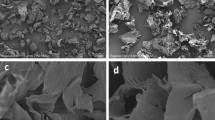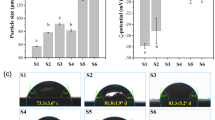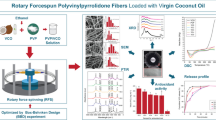Abstract
In this study, pea dietary fiber (PDF) was modified by dynamic high-pressure microfluidization (DHPM) technology with the aim to reveal the modulation of the structural and adsorption properties of PDF under different pressures. In addition, pea dietary fiber–chlorogenic acid complexes (PDF-CA) after DHPM treated were obtained, FT-IR showed that CA was interacting with PDF non-covalently through hydrogen bonding, and further investigated the interaction between PDF and CA, and synergistic action of CA and DHPM on PDF. Due to the molecular interplay of PDF-CA, the results showed that PDF and PDF-CA samples with different particle sizes could be obtained after DHPM treatment, the smallest particle sizes could be reduced by 48.92% and 49.19% compared to untreated samples, respectively. Microscopic evaluation of PDF and complexes also showed significant morphological changes; the crystallinity of both PDF and complexes decreased during the treatment, but the trend of thermal stability showed a different shift. In addition, PDF and PDF-CA made by the DHPM treatment exhibited better water-holding properties (increased by 85.47% and 52.01%) and oil-holding properties (increased by 33.42% and 39.79%); abilities to bind glucose and cholesterol. And the cholesterol adsorption capacity of PA and PDF-CA treated at the conditions of pH = 7, 120 MPa, could be increased from 1.23 to 2.67 mg/g, 2.64 to 7.06 mg/g, respectively. These results illustrated that the structural and adsorption properties of PDF could be effectively modified by DHPM and CA.










Similar content being viewed by others
Data Availability
Data sharing is not applicable – no new data generated, or the article describes entirely theoretical research.
References
Bai, X., He, Y., Quan, B., Xia, T., Zhang, X., Wang, Y., Zheng, Y., & Wang, M. (2022). Physicochemical properties, structure, and ameliorative effects of insoluble dietary fiber from tea on slow transit constipation. Food Chemistry, 14, 100340.
Bitik, A., Sumnu, G., & Oztop, M. (2019). Physicochemical and structural characterization of microfluidized and sonicated legume starches. Food and Bioprocess Technology, 12, 1144–1156.
Chu, J., Zhao, H., Lu, Z., Lu, F., Bie, X., & Zhang, C. (2019). Improved physicochemical and functional properties of dietary fiber from millet bran fermented by Bacillus natto. Food Chemistry, 294, 79–86.
Cui, W., Ma, Z., Li, X., & Hu, X. (2021). Structural rearrangement of native and processed pea starches following simulated digestion in vitro and fermentation characteristics of their resistant starch residues using human fecal inoculum. International Journal of Biological Macromolecules, 172, 490–502.
Gao, A., Yan, X., Xu, X., et al. (2015). Physicochemical and bioactive properties of soluble dietary fibers from blasting extrusion processing (BEP)-extruded carrot residues. Food and Bioprocess Technology, 8, 2036–2046.
Guo, Z., Ma, P., Diao, J., Li, C., Quan, Z., Man, Y., & Zhang, L. (2018). Physicochemical and adsorption properties of ultramicro insoluble dietary fiber from soybean hull. Food Science, 39(05), 106–112.
Howlett, J. F., Betteridge, V. A., Champ, M., Craig, S., & Jones, J. M. (2010). The definition of dietary fiber – Discussions at the Ninth Vahouny Fiber Symposium: Building scientific agreement. Food & Nutrition Research, 54, 5750.
Huang, J., Liao, J., Qi, J., Jiang, W., & Yang, X. (2020a). Structural and physicochemical properties of pectin-rich dietary fiber prepared from citrus peel. Food Hydrocolloids, 110, 106140.
Huang, S., He, Y., Qian, B., Zou, Y., & Liu, Z. (2015). Modification of insoluble dietary fiber in okara by high pressure homogenization and high hydrostatic pressure and functional properties of the modified product. Food Science, 36(15), 81–85.
Huang, Y., Du, H., Kamal, G. M., et al. (2020b). Studies on the binding interactions of grass carp (Ctenopharyngodon idella) myosin with chlorogenic acid and rosmarinic acid. Food and Bioprocess Technology, 13, 1421–1434.
Jia, M., Chen, J., Liu, X., Xie, M., Nie, S., Chen, Y., Xie, J., & Yu, Q. (2019). Structural characteristics and functional properties of soluble dietary fiber from defatted rice bran obtained through Trichoderma viride fermentation. Food Hydrocolloids, 94, 468–474.
Ke, Y., Chen, J., Dai, T., et al. (2022). Industry-scale microfluidizer: A novel technology to improve physiochemical qualities and volatile flavor of whole mango juice. Food and Bioprocess Technology, 16(5), 1022–1032.
Kehlet, U., Pagter, M., Aaslyng, M. D., & Raben, A. (2017). Meatballs with 3% and 6% dietary fibre from rye bran or pea fibre – Effects on sensory quality and subjective appetite sensations. Meat Science, 125, 66–75.
Li, A., Xie, B., Wang, J., & Tian, Y. (2010). Comparison on the preparation method function and structure of dietary fiber from bamboo shoots. Journal of Chinese Institute of Food Science and Technology, 10(1), 86–92.
Li, J., Wang, H., Yang, Q., Yang, J., Ji, W., Nan, X., & Sheng, G. (2022a). Effects of ultrafine grinded pea dietary fiber on intestinal flora and metabolites in diabetic mice. Food Science, 1–11.
Li, J., Wu, C., Ye, Q., Tang, Q., Meng, X., & Nie, X. (2021). Effect of different treatments on structure and hypoglycemic properties of okara dietary fibers. Food and Fermentation Industries, 47(15), 178–184.
Li, S., Hu, N., Zhu, J., Zheng, M., Liu, H., & Liu, J. (2022b). Influence of modification methods on physicochemical and structural properties of soluble dietary fiber from corn bran. Food Chemistry, 14, 100298.
Liu, X., Ma, S., He, G., Han, M., Yang, Y., & Guo, A. (2021). Comparison on chemical composition and physicochemical properties of pea dietary fiber and inulin. Food Industries, 42(09), 158–163.
Liu, Y., Zhang, W., Wang, K., et al. (2019). Fabrication of gel-like emulsions with whey protein isolate using microfluidization: Rheological properties and 3D printing performance. Food and Bioprocess Technology, 12, 1967–1979.
Liu, C., Liang, R., Dai, T., Ye, J., Zeng, Z., Luo, S., & Chen, J. (2016). Effect of dynamic high pressure microfluidization modified insoluble dietary fiber on gelatinization and rheology of rice starch. Food Hydrocolloids, 57, 55–61.
Lu, J., Qu, D., Liu, C., Zhang, L., Li, S., Chen, J., & Sun, Y. (2019). Structure, physicochemical properties and adsorption function of insoluble dietary fiber from ginseng residue: a potential functional ingredient. Food Chemistry, 286, 522–529.
Ma, M., & Mu, T. (2016). Modification of deoiled cumin dietary fiber with laccase and cellulase under high hydrostatic pressure. Carbohydrate Polymers, 136, 87–94.
Muneer, R. F., Johansson, E., Hedenqvist, M. S., Plivelic, T. S., Markedal, K. E., Petersen, I. L., Sørensen, J. C., & Kuktaite, R. (2018). The impact of newly produced protein and dietary fiber rich fractions of yellow pea (Pisum sativum L.) on the structure and mechanical properties of pasta-like sheets. Food Research International, 106, 607–618.
Oliete, B., Potin, F., Cases, E., et al. (2019). Microfluidization as homogenization technique in pea globulin-based emulsions. Food and Bioprocess Technology, 12, 877–882.
Oria, A. B., Gutiérrez, G. R., Prior, Á. F., Knicker, H., & Bolaños, J. F. (2019). Confirmation by solid-state NMR spectroscopy of a strong complex phenol-dietary fiber with retention of antioxidant activity in vitro. Food Hydrocolloids, 102, 105584.
Ou, S., Kwok, K. C., Li, Y., & Fu, L. (2001). In vitro study of possible role of dietary fiber in lowering postprandial serum glucose. Journal of Agriculture and Food Chemistry, 49(2), 1026–1029.
Pan, X., Fan, F., Ding, J., Li, P., Sun, X., Zhong, L., & Fang, Y. (2022). Altering functional properties of rice protein hydrolysates by covalent conjugation with chlorogenic acid. Food Chemistry, 14, 100352.
Pietrasik, Z., & Soladoye, O. P. (2021). Functionality and consumer acceptability of low-fat breakfast sausages processed with non meat ingredients of pulse derivatives. Journal of the Science of Food and Agriculture, 101(11), 4464–4472.
Qi, J., Li, Y., Masamba, K. G., Shoemaker, C. F., Zhong, F., Majeed, H., & Ma, J. (2016). The effect of chemical treatment on the in vitro hypoglycemic properties of rice bran insoluble dietary fiber. Food Hydrocolloids, 52, 699–706.
Rodríguez-Garayar, M., Martín-Cabrejas, M. A., & Esteban, R. M. (2017). High hydrostatic pressure in astringent and non-astringent persimmons to obtain fiber-enriched ingredients with improved functionality. Food and Bioprocess Technology, 10, 854–865.
Zhang, S., Guo, X., Ren, L., Yang, Y., Fan, J., Liu, L., Yu, D., Wu, N., Liu, B., & Zhang, N. (2022). Research progress of enzymatic modification on the composition and biological effects of dietary fiber. Journal of Food Safety and Quality, 13(04), 1089–1098.
Shi, J., Sui, Y., Cai, S., He, J., Xiong, T., Fan, C., Chen, X., Wang, S., Cai, F., & Mei, X. (2021). Comparison of physicochemical properties of wheat bran and its dietary fiber subjected to conventional crushing and superfine grinding. Modern Food Science & Technology, 37(01), 150–156.
Si, J., Yang, C., Ma, W., Chen, Y., Xie, J., Qin, X., Hu, X., & Yu, Q. (2022). Screen of high efficiency cellulose degrading strains and effects on tea residues dietary fiber modification: structural properties and adsorption capacities. International Journal of Biological Macromolecules, 220, 337–347.
Sun, C., Yang, J., Liu, F., et al. (2016). Effects of dynamic high-pressure microfluidization treatment and the presence of quercetagetin on the physical, structural, thermal, and morphological characteristics of Zein nanoparticles. Food and Bioprocess Technology, 9, 320–330.
Tan, C., Xu, Q. D., Chen, N., et al. (2022). Cross-linking modifications of different phenolic compounds on myofibrillar protein of common carp. Food and Bioprocess Technology, 16(3), 627–638.
Tang, C., Zhang, P., Yang, J., Wu, L., & Zheng, J. (2021). Effect of dynamic high-pressure micro-fluidization treatment on physicochemical and structural properties of square bamboo shoots dietary fiber. Food and Machinery, 37(6), 24–29.
Tao, S., Guo, X., Ling, B., & Ming, J. (2012). Physico-chemical properties and structure of modified dietary fiber from grape pomace. Food Science, 33(15), 171–177.
Tapia-Salazar, M., Arévalo-Rivera, I. G., Maldonado-Muñiz, M., et al. (2019). The dietary fiber profile, total polyphenol content, functionality of Silvetia compressa and Ecklonia arborea, and modifications induced by high hydrostatic pressure treatments. Food and Bioprocess Technology, 12, 512–523.
Tomas, M. (2021). Effect of dietary fiber addition on the content and in vitro bioaccessibility of antioxidants in red raspberry puree. Food Chemistry, 375, 131897.
Wang, D., Wang, K., Zhao, L., Liu, X., & Hu, Z. (2023). Fabrication and application of pickering emulsion stabilized by high pressure homogenization modified longan shell nanofiber. Journal of Food Engineering, 339, 111264.
Wang, L., Shi, K., Liao, C., Yuan, F., & Wang, Y. (2018). Study on functional and structure property of modified soluble dietary fiber from peanut. Food Industries, 4, 204–208.
Wang, L., Xu, H., Yuan, F., Pan, Q., Fan, R., & Gao, Y. (2015). Physicochemical characterization of five types of citrus dietary fibers. Biocatalysis and Agricultural Biotechnology, 4, 250–258.
Wang, M., Chen, X., Dong, L., Ji, W., Nan, X., & Zhou, Q. (2021). Effect of extrusion on the digestibility and viscosity properties of pea starch. Modern Food Science & Technology, 37(06), 231–236.
Wen, Y., Niu, M., Zhang, B., Zhao, S., & Xiong, S. (2017). Structural characteristics and functional properties of rice bran dietary fiber modified by enzymatic and enzyme-micronization treatments. LWT- Food Science and Technology, 75, 344–351.
Xu, W., Cui, W., Li, W., & Guo, W. (2004). Development and characterizations of super-fine wool powder. Powder Technology, 140, 136–140.
You, Y., Wang, Y., Zhang, J., Zheng, J., & Wu, L. (2021). The effect of high-pressure homogenization on physicochemical and structural properties of bamboo shoots dietary fiber. Food and Fermentation Industries, 47(10), 30–36.
Yu, Y., Zhao, J., Liu, J., Wu, J., Wang, Z., & Sun, Z. (2022). Improving the function of pickle insoluble dietary fiber by coupling enzymatic hydrolysis with HHP treatment. Journal of Food Science and Technology, 59, 4634–4643.
Zeng, W., Liao, J., & Qi, J. (2019). Effects of different treatments on morphology of citrus fibers. Modern Food Science & Technology, 35(02), 163–170.
Zhang, D. (2019). Effects of gallic acid and chlorogenic acid on the properties of phosphorylated myofibrils from chicken breast. Tianjin University of Commerce.
Zhang, N., Huang, C., & Ou, S. (2011). In vitro binding capacities of three dietary fibers and their mixture for four toxic elements, cholesterol, and bile acid. Journal of Hazardous Materials, 186, 236–239.
Zhao, W., & Chen, L. (2022). Physical and chemical properties and structural characterization of soluble dietary fiber from millet and its effects on the growth of seven kinds of intestinal bacteria in vitro. Journal of Chinese Institute of Food Science and Technology, 34(6), 50–58.
Zhong, J., Liu, C., Liu, W., & Sheng, P. (2009). Dynamic high pressure microfluidization (DHPM): whey protein solubility foaming ability: emulsifying ability rheological properties. Food Science, 30(14), 106–108.
Zhu, F. (2017). Interactions between cell wall polysaccharides and polyphenols. Critical Reviews in Food Science and Nutrition, 58, 1808–1831.
Zhu, Y., Guo, L., Chu, J., Lv, F., Lv, Z., Bie, X., Zhang, C., & Zhao, H. (2015). Effect of enzymatic treatment on cholesterol-binding capacity of dietary fiber from millet bran. Food Science, 36(19), 211–216.
Funding
This work was supported by the Shandong Province Key Research and Development Program Project (2019GNC106084); the Innovation Research Fund of Shandong University of Technology, Zhaoyuan Industrial Technology Research Institute (9101-2212401; 9101-220193); and the 2022 Postgraduate Teaching Case Bank for Professional Degrees in Shandong Province (4053-221033).
Author information
Authors and Affiliations
Contributions
Wei Ji. Guihua Sheng and Xijun Nan wrote the main manuscript text. Honglei Wang and Jiayi Li prepared the figures. Quancheng Zhou supervised the study.
Corresponding author
Ethics declarations
Conflict of Interest
The authors declare no competing interests.
Additional information
Publisher's Note
Springer Nature remains neutral with regard to jurisdictional claims in published maps and institutional affiliations.
Rights and permissions
Springer Nature or its licensor (e.g. a society or other partner) holds exclusive rights to this article under a publishing agreement with the author(s) or other rightsholder(s); author self-archiving of the accepted manuscript version of this article is solely governed by the terms of such publishing agreement and applicable law.
About this article
Cite this article
Ji, W., Sheng, G., Nan, X. et al. Dynamic High-Pressure Microfluidization of Pea Dietary Fiber: Modified Structural and Adsorption Properties and Interaction with Chlorogenic Acid. Food Bioprocess Technol 16, 2611–2621 (2023). https://doi.org/10.1007/s11947-023-03090-5
Received:
Accepted:
Published:
Issue Date:
DOI: https://doi.org/10.1007/s11947-023-03090-5




